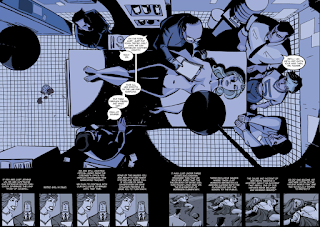Ten years prior to the start of this story, aliens had arrived on Earth. Unfortunately, all they did was plant/land massive Trees, which messed with the local environments. For the most part this was through seismic change and people’s fearful reactions, but some did eventually release toxic acid which killed everyone around them, while another has strange flowers growing near it. In the entire time the Trees have been there no alien has made contact, regardless of how hard humanity has tried to force them to. Because of this failure to communicate, most humans have learned to ignore them, even moving away if they can.
Thankfully, Warren Ellis goes beyond the usual alien encounter story. This isn’t an immediate fight for survival, but rather, a story that follows various individuals across the globe who are forced to face the changes brought about by their silent neighbours.
The cast of this story sounds like the set up for an inappropriate joke. There is a confused artist who moves to the experimental Chinese city of Shu. A Somalian head of state, a young lady under the protection of a fascist gang leader, as well as her new mentor, and entire team of scientists and engineers set up in a remote, frozen Norwegian location.
Unlike inappropriate jokes, however, there really wasn’t anything funny about this. This is more of a slow paced, thought provoking look at how humans react and interact during a crisis situation. Unfortunately, it was just a little too slow for me. I didn’t really care for any of the characters, and right up until the end there was very little action. I can appreciate the buildup, however, and I look forward to the story actually going somewhere.
Upon first look, I found the art to be a little jarring. There were so many extra lines, it was hard to tell if the Trees were supposed to look organic and similar to Earth trees, or if they were smooth and metallic. However, the art quickly grew on me, especially with the great scenic imagery and the expressiveness of the characters’ faces.







































